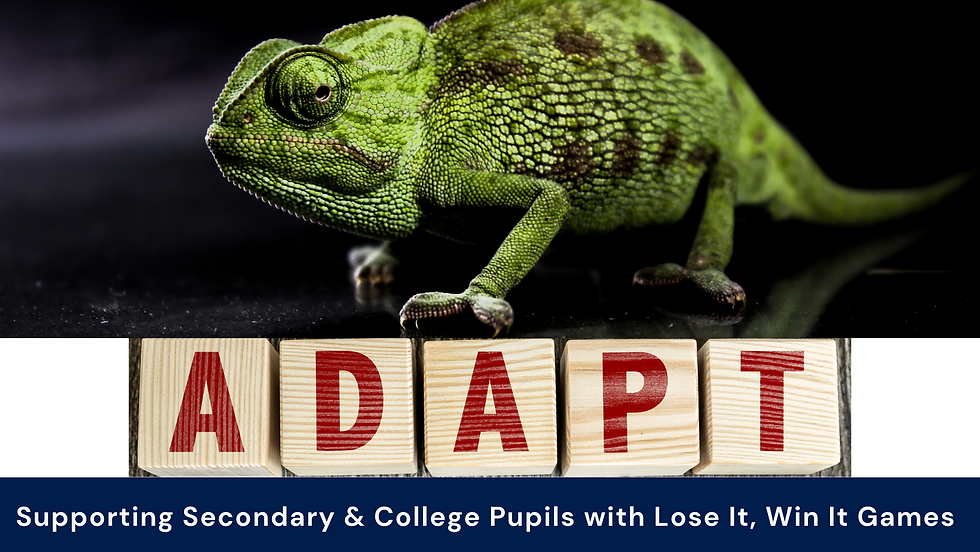🧩 Supporting Secondary & College Pupils with Lose It, Win It Games
- Sep 9
- 4 min read
One of the most common questions I receive from trainees is: “How do we make Lose It, Win It meaningful for teenagers and college students?”

With younger children, the game often focuses on basic turn-taking and sharing. But when working with older pupils, the aim goes much deeper. It’s about helping them develop emotional awareness, resilience, and self-regulation - skills they’ll use far beyond the classroom.
Here are some practical ways to adapt and deliver 'Lose It, Win It' (and its social story) so that it remains age-appropriate, engaging, and relevant for teenagers and young adults.
1. Set the Scene with Real-Life Connections
Older pupils may disengage if they don’t see the relevance. Before starting, explain why this matters:
“This game is a way to practise what happens when things don’t go the way we want—like not getting picked for a team, failing a test, or not being the first in line. These things happen in life, and how we respond can change how we feel afterwards.”
Invite them to share their own examples:
“When was the last time you lost something—a football match, a board game, even a TikTok challenge with friends?”
“What did you do? How did you feel in the moment?”
This personal reflection makes the learning more meaningful before the game even begins.
2. Add More Depth to the Game
Once pupils see the relevance, you can increase the challenge and ownership of the game itself.
Challenge Mode: Instead of just rolling dice, add strategy cards or timed problem-solving rounds.
Reflection Role: Assign one pupil as an observer who notes behaviours (e.g., who got frustrated, who encouraged others). Ultimately, the observer shares feedback with the group.
Peer Coaching: After each round, ask pupils to share one thing they did well (e.g., “I stayed calm when I lost”) and one thing they want to try differently next time.
3. Normalise and Explore Losing & Winning
This is an opportunity to teach pupils that thoughts, emotions, and behaviours accompany both outcomes.
Use structured prompts to reflect:
Situation: “I lost a football match with my team.”
Thoughts: “I’m rubbish at this. Everyone will blame me.”
Emotions: Frustrated, embarrassed, disappointed.
Body Sensations: Tight chest, sweaty palms, tense jaw.
Behaviour: I sulked and walked away.
Alternative Coping Strategy: “Next time, I could remind myself we win as a team, lose as a team—and maybe congratulate the other side instead.”
Model this by sharing a lighthearted example from your own life (e.g., losing at a card game but choosing to laugh it off).
4. Adapt the Social Story for Teens
The original social story may feel too young for this age group. Instead, use examples they’ll connect with:
Not being chosen for a lead role in a school play
A sibling or friend is doing better in exams
Losing a competitive video game
Not being first in the lunch queue
Pair these with “if/then” reflections:
“If I lose, I might feel frustrated—but I can still control what I say and do.”
“If I win, I can feel proud—but I don’t need to brag, because that might upset others.”
5. Build Emotional Regulation Skills in the Game
During play, prompt students to notice:
Thoughts: “What went through your mind when you lost that round?”
Emotions: “Did you feel angry, disappointed, embarrassed—or maybe okay with it?”
Body Reactions: “Did you notice your heartbeat faster, your face get hot, or your hands clench?”
Actions: “What did you do in that moment? Did you take a breath, stay quiet, laugh it off?”
Please encourage them to practise deep breathing, positive self-talk, or humour when frustration arises.
6. Debrief Together
After the game, always make time for reflection. Ask guiding questions such as:
“What was the hardest part about losing?”
“What helped you manage your reaction?”
“If you could go back and try again, what would you do differently?”
“How might you use what you practised here in school, sports, or with friends?”
Highlight small wins, such as staying calm, encouraging someone else, or noticing frustration before it escalates.
.
7. Keep It Age-Appropriate & Empowering
Finally, remember that older pupils won’t engage if it feels “babyish.”
Keep the pace quick, add humour, and use team challenges.
Let them adapt the rules themselves—this increases ownership and authenticity.
✅ Key takeaway for trainees: Lose It, Win It isn’t just about bricks, dice, or turns—it’s a structured opportunity for young people to practise handling disappointment and success, reflect on their emotions, and transfer those skills into real-life challenges.
💡 When we use playful activities in secondary and college settings, it’s not about the game itself—it’s about creating safe, structured opportunities for growth. With the right adaptations, this simple activity becomes preparation for handling the wins and losses that shape everyday life.
⚠️ Disclaimer: The ideas shared in this blog reflect my own perspective and professional experience. When adapting activities such as Lose It, Win It, please remember to follow good practice and take a person-centred approach. Always use your professional knowledge and judgement to ensure the strategies fit the needs of the individual pupils you are supporting.
❓I’d love to hear your thoughts—how do you approach supporting teenagers and young adults with the challenges of winning and losing? Have you tried adapting Lose It, Win It or similar activities in your own setting? Please share your experiences, reflections, or tips in the comments below—I’m always eager to learn from the diverse ways professionals apply these ideas in practice.
Until the next time,
Beata Bednarska







Comments